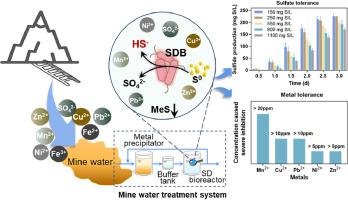当前位置:
X-MOL 学术
›
Water Res.
›
论文详情
Our official English website, www.x-mol.net, welcomes your
feedback! (Note: you will need to create a separate account there.)
Adaptability of sulfur-disproportionating bacteria for mine water remediation under the pressures of heavy metal ions and high sulfate content
Water Research ( IF 11.4 ) Pub Date : 2023-11-19 , DOI: 10.1016/j.watres.2023.120898 Yan-Ying Qiu 1 , Jiahui Zou 1 , Juntao Xia 1 , Hao Li 1 , Yuming Zhen 1 , Yanduo Yang 1 , Jiahua Guo 1 , Liang Zhang 1 , Rongliang Qiu 2 , Feng Jiang 3
Water Research ( IF 11.4 ) Pub Date : 2023-11-19 , DOI: 10.1016/j.watres.2023.120898 Yan-Ying Qiu 1 , Jiahui Zou 1 , Juntao Xia 1 , Hao Li 1 , Yuming Zhen 1 , Yanduo Yang 1 , Jiahua Guo 1 , Liang Zhang 1 , Rongliang Qiu 2 , Feng Jiang 3
Affiliation

|
Biological sulfide production processes mediated by sulfate/sulfur reduction have gained attention for metal removal from industrial wastewater (e.g., mine water (MW) and metallurgical wastewater) via forming insoluble metal sulfides. However, these processes often necessitate the addition of external organic compounds as electron donors, which poses a constraint on the broad application of this technology. A recent proof of concept study reported that microbial sulfur disproportionation (SD) produced sulfide with no demand for organics, which could achieve more cost-benefit MW treatment against the above-mentioned processes. However, the resistance of SD bioprocess to different metals and high sulfate content in MW remains mysterious, which may substantially affect the practical applicability of such process. In this study, the sulfur-disproportionating bacteria (SDB)-dominated consortium was enriched from a previously established SD-driven bioreactor, in which Dissulfurimicrobium sp. with a relative abundance of 39.9 % was the predominated SDB. When exposed to the real pretreated acidic MW after the pretreatment process of pH amelioration, the sulfur-disproportionating activity remained active, and metals were effectively removed from the MW. Metal tolerance assays further demonstrated that the consortium had a good tolerance to different metal ions (i.e., Pb2+ , Cu2+ , Ni2+ , Mn2+ , Zn2+ ), especially for Mn2+ with a concentration of approximately 20 mg/L. It suggested the robustness of Dissulfurimicrobium sp. likely due to the presence of genes encoding for the enzymes associated with metal(loid) resistance/uptake. Additionally, although high sulfate content resulted in a slight inhibition on the sulfur-disproportionating activity, the consortium still achieved sulfide production rates of 27.3 mg S/g VSS-d on average under an environmentally relevant sulfate level (i.e., 1100 mg S/L), which is comparable to those reported in sulfate reduction. Taken together, these findings imply that SDB could ensure sustainable MW treatment in a more cost-effective and organic-free way.
中文翻译:

重金属离子和高硫酸盐压力下硫歧化细菌对矿井水修复的适应性
由硫酸盐/硫还原介导的生物硫化物生产过程通过形成不溶性金属硫化物从工业废水(例如矿井水(MW)和冶金废水)中去除金属而受到关注。然而,这些过程通常需要添加外部有机化合物作为电子给体,这限制了该技术的广泛应用。最近的一项概念验证研究报告称,微生物硫歧化(SD)产生硫化物而不需要有机物,与上述过程相比,这可以实现更具成本效益的MW处理。然而,SD生物工艺对不同金属的耐受性和MW中高硫酸盐含量仍然是个谜,这可能会严重影响该工艺的实际适用性。在这项研究中,以硫歧化细菌 (SDB) 为主的菌群从先前建立的 SD 驱动的生物反应器中得到富集,其中 Dissulfurimicrobium sp。相对丰度为 39.9% 的是占主导地位的 SDB。当在pH值改善的预处理过程后暴露于真正预处理的酸性MW时,硫歧化活性仍然活跃,并且金属被有效地从MW中去除。金属耐受性测定进一步表明,该联合体对不同金属离子(即Pb2+、Cu2+、Ni2+、Mn2+、Zn2+)具有良好的耐受性,特别是对浓度约为20 mg/L的Mn2+。这表明二硫微生物菌属 sp. 的稳健性。可能是由于存在编码与金属(类)抗性/吸收相关的酶的基因。 此外,尽管高硫酸盐含量导致对硫歧化活性的轻微抑制,但该联合体在环境相关硫酸盐水平(即1100 mg S/L)下仍然实现了平均27.3 mg S/g VSS-d的硫化物生产率),这与硫酸盐还原报道的结果相当。总而言之,这些发现意味着 SDB 可以以更具成本效益和无有机物的方式确保可持续的微波处理。
更新日期:2023-11-19
中文翻译:

重金属离子和高硫酸盐压力下硫歧化细菌对矿井水修复的适应性
由硫酸盐/硫还原介导的生物硫化物生产过程通过形成不溶性金属硫化物从工业废水(例如矿井水(MW)和冶金废水)中去除金属而受到关注。然而,这些过程通常需要添加外部有机化合物作为电子给体,这限制了该技术的广泛应用。最近的一项概念验证研究报告称,微生物硫歧化(SD)产生硫化物而不需要有机物,与上述过程相比,这可以实现更具成本效益的MW处理。然而,SD生物工艺对不同金属的耐受性和MW中高硫酸盐含量仍然是个谜,这可能会严重影响该工艺的实际适用性。在这项研究中,以硫歧化细菌 (SDB) 为主的菌群从先前建立的 SD 驱动的生物反应器中得到富集,其中 Dissulfurimicrobium sp。相对丰度为 39.9% 的是占主导地位的 SDB。当在pH值改善的预处理过程后暴露于真正预处理的酸性MW时,硫歧化活性仍然活跃,并且金属被有效地从MW中去除。金属耐受性测定进一步表明,该联合体对不同金属离子(即Pb2+、Cu2+、Ni2+、Mn2+、Zn2+)具有良好的耐受性,特别是对浓度约为20 mg/L的Mn2+。这表明二硫微生物菌属 sp. 的稳健性。可能是由于存在编码与金属(类)抗性/吸收相关的酶的基因。 此外,尽管高硫酸盐含量导致对硫歧化活性的轻微抑制,但该联合体在环境相关硫酸盐水平(即1100 mg S/L)下仍然实现了平均27.3 mg S/g VSS-d的硫化物生产率),这与硫酸盐还原报道的结果相当。总而言之,这些发现意味着 SDB 可以以更具成本效益和无有机物的方式确保可持续的微波处理。













































 京公网安备 11010802027423号
京公网安备 11010802027423号